Smart lighting control for home transforms ordinary living spaces into efficient, convenient, and secure environments. Imagine walking into a room where lights adjust automatically to your presence or mood. This technology offers significant benefits, including up to 90% reduction in energy costs, according to Gartner. Modern homes increasingly adopt smart lighting, with 21% of US broadband households already owning a smart lighting product. Enhance your home’s ambiance, security, and energy efficiency with this innovative solution.
Understanding Smart Lighting Control for Home

What is Smart Lighting Control for Home?
Smart lighting control for home involves using technology to manage and automate your home's lighting. Imagine controlling all your lights with a smartphone or voice command. This system includes various components that work together seamlessly.
Definition and Basic Concept
Smart lighting control for home refers to a system where lights can be controlled remotely. You can adjust brightness, change colors, and set schedules. This system often uses Wi-Fi, Bluetooth, or other wireless technologies.
Key Components of a Smart Lighting System
A smart lighting system consists of several key components:
- Smart Bulbs: These bulbs connect to your home network and can be controlled via an app.
- Smart Switches: These replace traditional wall switches and offer more control options.
- Hubs or Bridges: These devices act as intermediaries between your lights and your control devices.
- Sensors: Motion sensors can trigger lights based on movement, enhancing security and convenience.
Benefits of Smart Lighting Control for Home
Smart lighting control for home offers numerous benefits that make it a worthwhile investment.
Energy Efficiency
Smart lighting systems help reduce energy consumption. Lights can turn off automatically when not in use. This feature can lead to significant savings on your electricity bill.
Convenience and Automation
Smart lighting brings unparalleled convenience. You can control your lights from anywhere using your smartphone. Set schedules to have lights turn on or off at specific times. Voice assistants like Alexa and Google Assistant can also control your lights.
Enhanced Security
Smart lighting enhances home security. Schedule lights to turn on when you are away to give the appearance that someone is home. Motion sensors can also trigger lights, deterring potential intruders.
Types of Smart Lighting Systems
Different types of smart lighting systems cater to various needs and preferences.
Wi-Fi Based Systems
Wi-Fi based systems connect directly to your home network. These systems are easy to set up and offer extensive control options. However, they may consume more bandwidth.
Bluetooth Based Systems
Bluetooth based systems connect directly to your smartphone or tablet. These systems are ideal for smaller setups and do not require a hub. However, their range is limited compared to Wi-Fi systems.
Zigbee and Z-Wave Systems
Zigbee and Z-Wave systems use mesh networking technology. These systems require a hub but offer robust and reliable connections. They are ideal for larger homes with multiple smart devices.
Planning Your Smart Lighting Setup

Assessing Your Needs
Identifying Areas to Automate
Start by walking through your home and identifying areas where smart lighting control for home can make a difference. Think about rooms where you often forget to turn off the lights. Consider spaces where you want to create a specific ambiance, like the living room or bedroom. Hallways and closets also benefit from automation, providing light only when needed.
Determining the Number of Lights and Switches
Count the number of lights and switches in each identified area. This step helps in planning your budget and ensures you purchase the right amount of equipment. For instance, a large living room might need multiple smart bulbs or switches to cover all lighting needs. Smaller spaces like closets might only need one smart bulb.
Choosing the Right Products
Smart Bulbs vs. Smart Switches
Decide between smart bulbs and smart switches based on your needs. Smart bulbs are easy to install and offer color-changing options. They fit into existing fixtures and connect to your home network. Smart switches replace traditional wall switches and control multiple lights at once. They provide a more integrated solution but require some electrical work.
Compatibility with Existing Systems
Check the compatibility of smart lighting products with your existing systems. Ensure that the smart bulbs or switches you choose work with your home’s Wi-Fi or other wireless technologies. Some systems might require a hub or bridge for optimal performance. Compatibility with voice assistants like Alexa or Google Assistant enhances convenience.
Budget Considerations
Plan your budget carefully. Smart lighting control for home can range from affordable to high-end, depending on the features and brand. Prioritize essential areas first if you have a limited budget. Expand your system gradually as funds allow. Remember, investing in energy-efficient smart lighting can save money in the long run.
Creating a Layout Plan
Mapping Out Your Home
Create a map of your home to visualize your smart lighting setup. Mark the locations of existing lights and switches. Identify areas where you plan to install new smart bulbs or switches. This visual aid helps in organizing your installation process and ensures no area gets overlooked.
Deciding on Control Points
Determine the control points for your smart lighting system. Decide where to place smart switches for easy access. Consider using motion sensors in hallways or entry points for added convenience. Plan the placement of hubs or bridges if required. Ensure that control points are accessible and convenient for all family members.
Installing Smart Lighting

Setting Up Smart Bulbs
Installation Process
Start by choosing the right smart bulbs for your home. Lumary's Smart String Down Lights offer a flexible installation design that fits into any home layout. Screw the smart bulb into an existing light fixture. No need for professional electrical work. Ensure the power is off before starting to avoid any accidents.
Connecting to the Network
After installing the smart bulb, connect it to your home network. Use the Lumary APP to guide you through this process. Open the app and follow the on-screen instructions. Connect the bulb to your Wi-Fi network. Once connected, you can control the bulb using your smartphone or voice assistant.
Installing Smart Switches
Safety Precautions
Before installing smart switches, prioritize safety. Turn off the power at the circuit breaker. Use a voltage tester to ensure no electricity flows through the wires. Wear insulated gloves to protect yourself from electric shocks.
Step-by-Step Installation Guide
- Remove the existing wall switch by unscrewing it.
- Disconnect the wires from the old switch.
- Connect the wires to the new smart switch. Follow the manufacturer's instructions for proper wiring.
- Secure the smart switch into the wall box with screws.
- Turn the power back on at the circuit breaker.
- Test the switch to ensure it works correctly.
Configuring the System
Using the App for Setup
Open the Lumary APP to configure your smart lighting control for home. The app provides step-by-step guidance. Add each smart bulb and switch to the app. Name each device for easy identification. Group devices by room or function for better organization.
Customizing Settings and Preferences
Customize your smart lighting system to suit your needs. Adjust brightness levels and color temperatures. Set schedules for automatic on/off times. Use the app to create scenes for different moods and activities. For example, set a relaxing scene for movie nights or a bright scene for reading.
"Smart lighting is an integrated system that involves segments such as light sources, luminaries, sensors & control units, connectivity, and analytics."
With Lumary's Smart String Down Lights, enjoy multiple control options. Use the app, voice commands, remote controller, or control box. Elevate your home lighting experience with features like music mode, where lights sync to the beat of your favorite tunes. Enhance your home's ambiance, security, and energy efficiency with smart lighting control for home.
Using and Maintaining Your Smart Lighting System

Daily Use
Voice Control Options
Voice control options offer a hands-free way to manage smart lighting control for home. Imagine saying, "Alexa, turn on the living room lights," and watching the room illuminate instantly. Voice assistants like Alexa, Google Assistant, and Siri can integrate seamlessly with your smart lighting system. These voice commands provide convenience, especially when your hands are full or when you want to impress guests with your tech-savvy home.
Scheduling and Automation
Scheduling and automation features elevate smart lighting control for home to another level. Set schedules for your lights to turn on or off at specific times. This feature ensures that your home always has the right ambiance. For example, schedule your bedroom lights to dim gradually in the evening, creating a relaxing atmosphere for winding down. Automation can also enhance security by making it seem like someone is home even when the house is empty.
Troubleshooting Common Issues
Connectivity Problems
Connectivity problems can disrupt smart lighting control for home. If your lights fail to respond, check your Wi-Fi connection first. Ensure that your smart bulbs and switches are within range of your router. Restart your router if necessary. Sometimes, interference from other devices can cause connectivity issues. Try moving your smart hub or bridge to a different location to improve signal strength.
Firmware Updates
Firmware updates keep your smart lighting control for home running smoothly. Manufacturers release updates to fix bugs and add new features. Regularly check for firmware updates through your smart lighting app. Follow the instructions to update your devices. Keeping your firmware up-to-date ensures optimal performance and security for your smart lighting system.
Maintenance Tips
Regular Updates and Checks
Regular updates and checks are essential for maintaining smart lighting control for home. Periodically review your lighting schedules and automation settings. Ensure that all your devices are functioning correctly. Check for app updates as well. Updated apps often come with improved user interfaces and additional features.
Ensuring Optimal Performance
Ensuring optimal performance involves a few simple steps. Clean your smart bulbs and switches to remove dust and debris. Dust can affect the brightness and responsiveness of your lights. Test your motion sensors regularly to ensure they trigger lights as expected. Adjust the sensitivity settings if needed. Routine maintenance helps prolong the life of your smart lighting system and keeps your home shining bright.
Avisio UK states, "Smart lighting is great for security, energy efficiency and for simply making your home more pleasant to be in." This testimonial highlights the multifaceted benefits of smart lighting control for home. Enjoy the convenience, enhanced security, and energy savings that come with a well-maintained smart lighting system.
Smart lighting offers numerous benefits. Enjoy energy savings, convenience, and enhanced security. Imagine never needing to use a physical light switch again. Start your setup process today. Installation is simple and can be done by anyone who can navigate a smartphone app and change a light bulb.
Final Tips:
- Start Small: Begin with one room.
- Use Voice Control: Integrate with Alexa or Google Assistant.
- Regular Maintenance: Keep firmware updated for optimal performance.
Transform your home with smart lighting. Embrace the future of home automation.

















